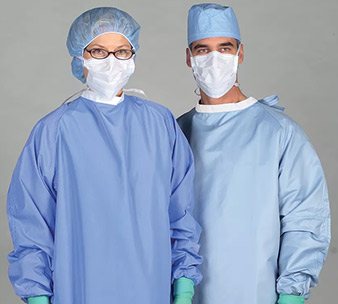Hospital Gowns: A Protective Shield for Healthcare Workers and Patients
Hospital gowns are regarded as vital protective equipment in the healthcare sector. For healthcare workers, they offer personal protection during patient contact and help minimize infection risks. Simultaneously, they help create a hygienic environment for patients, reducing cross-contamination. Regular sterilization of hospital gowns is a fundamental component of infection control measures, enhancing their efficacy and safety.
Types of Hospital Gowns
- Neonatal Gowns: Specially designed for neonatal or intensive care units, these gowns protect infants’ sensitive skin and ensure extra hygiene.
- Radiology Gowns: Worn by staff exposed to radiation, these gowns are made from lead or lead-containing materials to safeguard against harmful rays.
- ICU Gowns: Used in intensive care units, these gowns are typically waterproof and easy to clean, as hygiene is crucial in these settings.
- Medical Implant Gowns: Used during surgeries involving implants or prosthetics, they maintain a sterile environment and minimize contamination risks.
- Veterinary Gowns: Worn by veterinary professionals, these gowns prevent zoonotic cross-infection and protect both staff and animals.
Use Cases and Features
- Protection Levels: Different gowns offer varying protection levels. Surgical gowns are fluid-resistant and highly sterile, while patient gowns are lighter and easy to change.
- Hygiene Standards: Gowns must meet healthcare standards governing cleaning and disinfection protocols.
- Chemical and Fire Resistance: Laboratory gowns are often resistant to chemicals and flame to reduce risks in lab environments.
- Color and Design Variants: Color-coded or uniquely styled gowns help distinguish departments or purposes easily.
- Allergy-Friendly: Some gowns avoid allergenic materials to accommodate sensitive skin, enhancing safety and comfort.
Hygiene and Safety
- Infection Prevention & Cross-Contamination: By maintaining hygiene standards, gowns reduce infection spread within hospitals—for both patients and staff.
- Chemical & Biological Protection: Lab gowns shield against hazardous chemicals and biological threats, safeguarding staff health.
- Professional Appearance & Order: Standardized gowns support a professional hospital image and inspire trust among patients and visitors.
- Reduced Transmission Risks: Gowns help prevent transmission between patients or between staff and patients, lowering outbreak risks.
- Increased Comfort & Performance: Well-designed gowns enhance comfort and ease of movement, improving care quality.
Choosing the Right Hospital Gown
- Material Matching to Use Case: For example, waterproof gowns are suitable for surgery, breathable gowns better for general care.
- Material Quality & Sterilization Compatibility: Assess aspects like breathability, durability, and sterilization capability.
- Design & Usability: Gowns should be easy to put on and remove, flexible, and available in sizes that fit.
- Compliance with Hygiene Standards: Materials must be easy to disinfect and free from microbes.
- Cost-Effectiveness & Longevity: Consider long-term cost savings versus upfront investment in durable, high-quality gowns.
Frequently Asked Questions
- What are hospital gowns used for?
They are used to protect healthcare workers’ hygiene and safety, prevent infection spread, shield against chemicals and biological hazards, and maintain a professional appearance. - How should hospital gowns be chosen?
Consider material quality, design features (ease of wear, flexibility, correct sizing), sterilization properties, hygiene compliance, and cost-effectiveness. - How are hospital gowns cleaned and sterilized?
They are typically washable at high temperatures or go through specialized sterilization methods, adjusted as per usage environment and fabric type. - How often should hospital gowns be changed?
Frequency depends on hygiene protocols and the condition of the gown. Generally, they should be replaced daily or after each use. - What hazards do hospital gowns protect against?
They prevent the spread of infectious diseases, provide chemical protection, and act as a physical barrier against biological threats.
